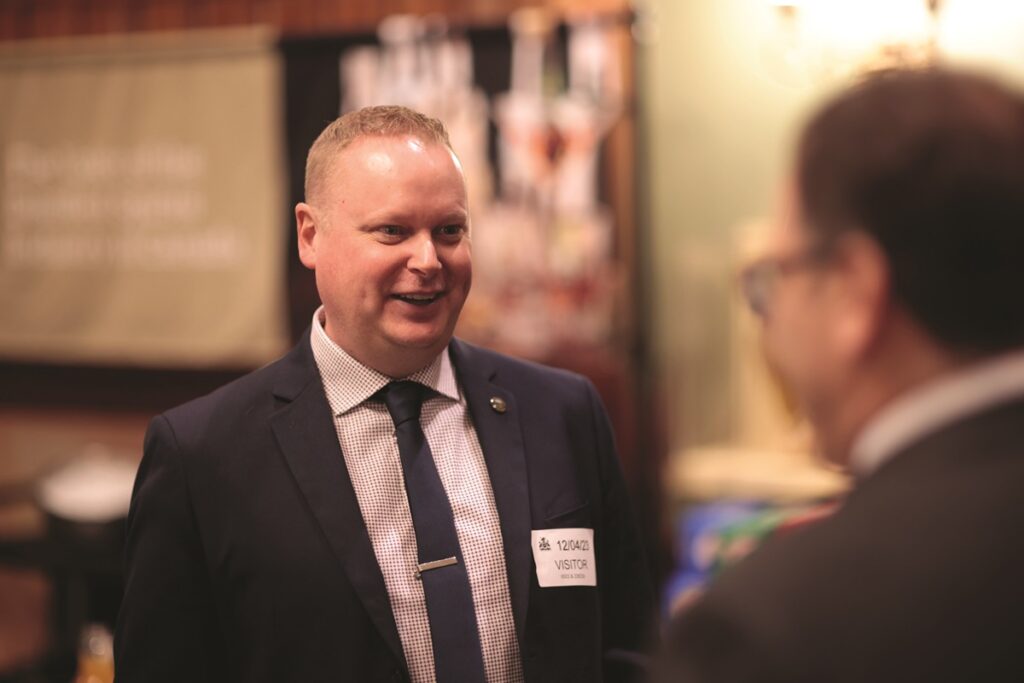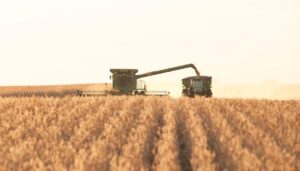The next chapter
BRENDAN BYRNE FINISHES TERM AS GRAIN FARMERS OF ONTARIO CHAIR

LIKE MOST GOOD STORIES, THE STORY OF HOW BRENDAN BYRNE ended up as chair of Grain Farmers of Ontario doesn’t follow a straight line. With a few twists and turns and a cast of supporting characters, Byrne made his way from Essex County farm kid to chair of Ontario’s largest farm organization, taking him on a journey that saw him travel across Canada and around the world, meet with provincial, national, and international leaders, and lead the organization through not one, but several, unprecedented global crises.
BEFORE GRAIN FARMERS OF ONTARIO
Byrne grew up in Essex County, where his family has been farming for over 100 years. He describes his farm as a “typical corn, soybean, wheat farm.” About 20 years ago, Byrne says he was offered the opportunity to come home to manage the farm full time — but becoming a farmer wasn’t always in the cards.
“I now say to my kids, chase any dream that you have, and the farm is going to be here … if you want to come back, great, but if you have something that is your passion and that you love, follow that.”
Byrne followed that advice by pursuing a business and economics degree at the University of Windsor, with the goal of establishing a career path in business. From there, he went on to sell high-end art for a number of years and worked in feature film and music video production. The farm was something that he would come back to when he could; a ‘part-time’ pursuit, he describes.
GETTING ON BOARD
When he first returned to the farm full-time, Byrne’s dad encouraged him to attend some of the local farm meetings.
“My dad said, ‘I don’t always have time to go to all these meetings, so why don’t you go and see what they’re up to and what you can bring back to us,’” says Byrne. Getting involved first with the Essex Soil and Crop Improvement Association, Byrne took on a board position and later a role on the local soybean committee. When Grain Farmers of Ontario was formed in 2010, Byrne was elected as a delegate, then chaired District 1 (Essex) for several years and sat on several Grain Farmers of Ontario committees.
Taking the next step into a board position came at the encouragement of Leo Guilbeaut, a past president of the Ontario Soybean Growers and District 1’s (Essex) first Grain Farmers of Ontario director.
“He would keep checking in with me … he thought I could step in after him,” says Byrne. In 2015, Byrne was elected to the Grain Farmers of Ontario Board of Directors.
THE PATH TO CHAIR
Byrne joined the executive committee in 2018 and, a year later, was elected as vice chair. Following Marcus Haerle’s term as chair, Byrne says there was “overwhelming support from the board for me to move into the chair.”
“Barry [Senft] was very supportive, in the time that he was there as CEO, in the same way that Crosby [Devitt] has been,” says Byrne. “Over the years, the executive and chairs and members of the Board, like Mark Brock, Mark Huston, Henry Van Ankum, Marcus Haerle, Kevin Armstrong — those are the ones that I spent time learning from.”
Byrne says he has also appreciated unwavering support from his family — including wife Mindy and children Brendan and Alyssa.
BIGGEST CHALLENGES
Byrne’s term as chair of Grain Farmers of Ontario was marked by several unprecedented events — his term as chair started amid the global Covid-19 pandemic; the Russian invasion of Ukraine led to a crisis in fertilizer supply and prices; and most recently, a strike by St. Lawrence Seaway workers threatened to shut down Ontario grain exports right at the height of harvest. Domestically, Byrne has led the charge in advocating for relief from the federal carbon tax on grain drying and increased support for business risk management programs provincially. Farmer mental health and equity, diversity, and inclusion efforts in agriculture are two industry-wide issues that he’s taken a personal interest in and taken a leadership role in advancing.
“The biggest challenge has always come down to the same thing — communication,” says Byrne. “During Covid, it was hard to communicate with people like we normally did … those other issues, it came down to communicating with the government how important it was to allow fertilizer to come in, how important it was for the Seaway to open, to communicate the needs of farmers to keep money in their pocket rather than on carbon tax for grain drying.”
Crosby Devitt, Grain Farmers of Ontario CEO, says Byrne has been a tremendous leader and strong voice for the industry.
“Brendan always makes himself available whenever he’s needed,” says Devitt. “He has been a steadfast supporter of Ontario’s grain farmers and has worked hard to advance the interests of the grain and oilseed industry.”
Victoria Berry, manager of communications, points to the Seaway strike as an example of Byrne’s exceptional communication skills and ability to break down the issues that affect farmers to bring consumers and politicians on board.
“During the Seaway strike, Brendan was making videos from his combine and doing interviews with provincial and national media to explain how the strike would impact the movement of grain and the livelihood of Ontario farmers,” she says. “He played an important role in framing the conversation in a way that brought grain farming to the forefront of the discussion.”
While there have been varying levels of success in each of the issues the organization has faced over the past three years, Byrne says he is proud of how the Board has responded and the work they’ve done on behalf of farmer-members — noting that there is still much more to accomplish in the future.
“The biggest takeaway is that we can only control the effort; we can’t control the result. So as long as, at the end of the day, you’re comfortable with the amount of effort that you put into these issues, and you think you did everything you could, it makes it a little easier to look back and say we did a good job.”
WHAT’S NEXT?
Brendan’s Grain Farmers of Ontario story isn’t over; he remains on the Board as director for District 1 (Essex). But he is looking forward to a slightly slower pace and has some farm and personal projects lined up to fill the time.
“On the farm, we had a tornado come through last summer … we’re going to build a new farm shop over the spring and summer,” he says. “I’ve got piles of books to read … and I’m going to take some time to plan what the next steps are.” But first up is a vacation with his wife, Mindy, and some family trips to thank them for their ongoing support.
“I see myself continuing in some aspect of amplifying the voices of farmers.” he says. •

























